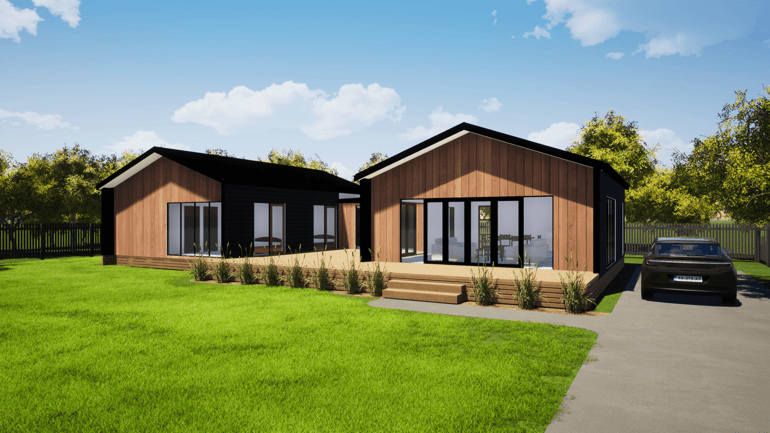What is a modular home?
Creative alternatives to housing are emerging across the country providing buyers with many non-mainstream options to build a new home. And while variety is a wonderful thing, the many terms used to explain them can be daunting. Phrases such as prefab homes, transportable homes, modular homes, tiny homes, and kitset homes being used interchangeably, can cause much confusion if you're trying to distinguish the differences between them all. This blog offers clarity on one of these popular alternative ways of building, by delving specifically into modular homes. We decipher what they are and how they compare to prefab homes.
What is a modular home?
Modular homes typically refer to homes that are factory-built in ‘modules’, or sections, and then delivered to their site where the modules are assembled and permanently fixed to the site foundations. Once assembled, it follows suit to a regular home, taking on the same look of a traditional home, hooked up to the usual utilities, and kitted out with all the same bells and whistles.
Sounds like a prefab home right! So is it? The short answer is, yes, modular homes are prefabs. However, not all prefabs are modular. Let us explain.
Similarities between prefabs and modular homes
Modular homes parallel with prefabs in that they too are built in a factory, delivered, then permanently fixed to a site. Just as with regular prefabs, factory-built doesn’t equal lesser-value than conventional builds, it simply means ‘efficient’. All prefabs and modular homes are built to an exceptional level of quality and consistency across the board. They also come in a wide variety of styles and sizes and are customisable to suit your ideal style and layout too. Factory-built arguably equals better quality as it’s built in a controlled environment where no weather complications will arise and is built by experienced labourers in their familiar settings. Once the house is complete and fixed to its site, there’ll be no way of knowing your new home was factory built in the first place. The only clue might be the extra savings in your bank from the lower overall cost you likely paid. Factory-built homes whether that be modular, or prefab, guarantee a lower cost than typical builds due to the controlled work conditions, the ability to bulk buy supplies, the reduced travel costs, and the minimal construction waste, leaving you less likely to break the bank.
It’s important to recognise too that both prefab and modular homes appraise the same as their conventionally constructed counterparts. They’ll still qualify for home loans, and will not depreciate in the way that a mobile or tiny home would.
Differences between prefabs and modular homes
As we explained earlier, all modular homes are prefabricated, but not all prefabs are modular. The key difference is that ‘modular’ refers to the process of pre-fabricating sections of the house and then connecting them on site.
The scope of modular homes varies significantly across the market but in theory, can embody any style or design you so desire. A common misconception is that a modular home is typically small, limited to ‘pods’, and compares more closely with a tiny home than a traditional home. And while many small modular homes exist on the market, the mere modularity of these homes means that the home can be as large or small as you want. It will just depend on the number and variety of modules included. Take Nook homes as an example. With their modular container-like sections it’s possible to create a sprawling, multi-story home by stacking modules on top of each other. Just be wary that every additional module comes with an additional transport cost that will need to be factored into the final budget.
A modular home can essentially match the look, feel, and design of a regular home, leaving no trace of being originally built in modules, if that’s the look you seek. Other modular homes fully embrace the modularity, allowing the finished result to take on a unique boxy-style home that embodies various pods strategically mustered together. The choice is up to you!
Modular home companies that specialise in the true modular, pod-like look, can be a great option for buyers looking at smaller, unique, and often shipping-container style homes. Additionally, it can be ideal for those looking to start small with plans to add additional pods over time, multiplying the space and adjoining rooms to the home as needed. Just be open with your modular home provider about your future plans early on.
Depending on your desired style and function, however, a prefab home provider could supply the modular home you need. Many prefab homes companies build modular homes. At Genius Homes all our houses are prefabricated, built in our Timaru factory then delivered across the South Island. And due to the size and design of some of our prefabs, there are several that fall into the classification of ‘modular’ too. Take, for example, the Benmore design. This modern home exemplifies the modular style by separating the living and sleeping quarters creating a sheltered, social outdoor hub. A design like this amplifies the size of the home, maximises the indoor-outdoor flow, and boasts a unique U-shaped style and layout.
 Benmore - 3 bedroom prefab home
Benmore - 3 bedroom prefab home
The take-home message is that there is a world of possibilities out there for new homes! With an increased demand for efficient, affordable, and quality homes, construction options such as prefabs and modular homes are growing in popularity and the variety of options available are endless.
Do your research, determine what your priorities are, whether that be style, budget, convenience, speed, or size, and go from there. If you like the prefab styles and designs Genius Homes offer, get in touch with one of the team to discuss your prefab possibilities. Or continue on your hunt for your ideal home by using our Dream Home Finder below.
